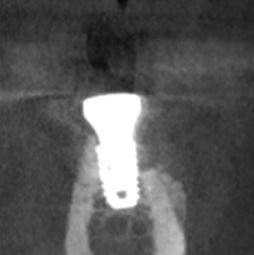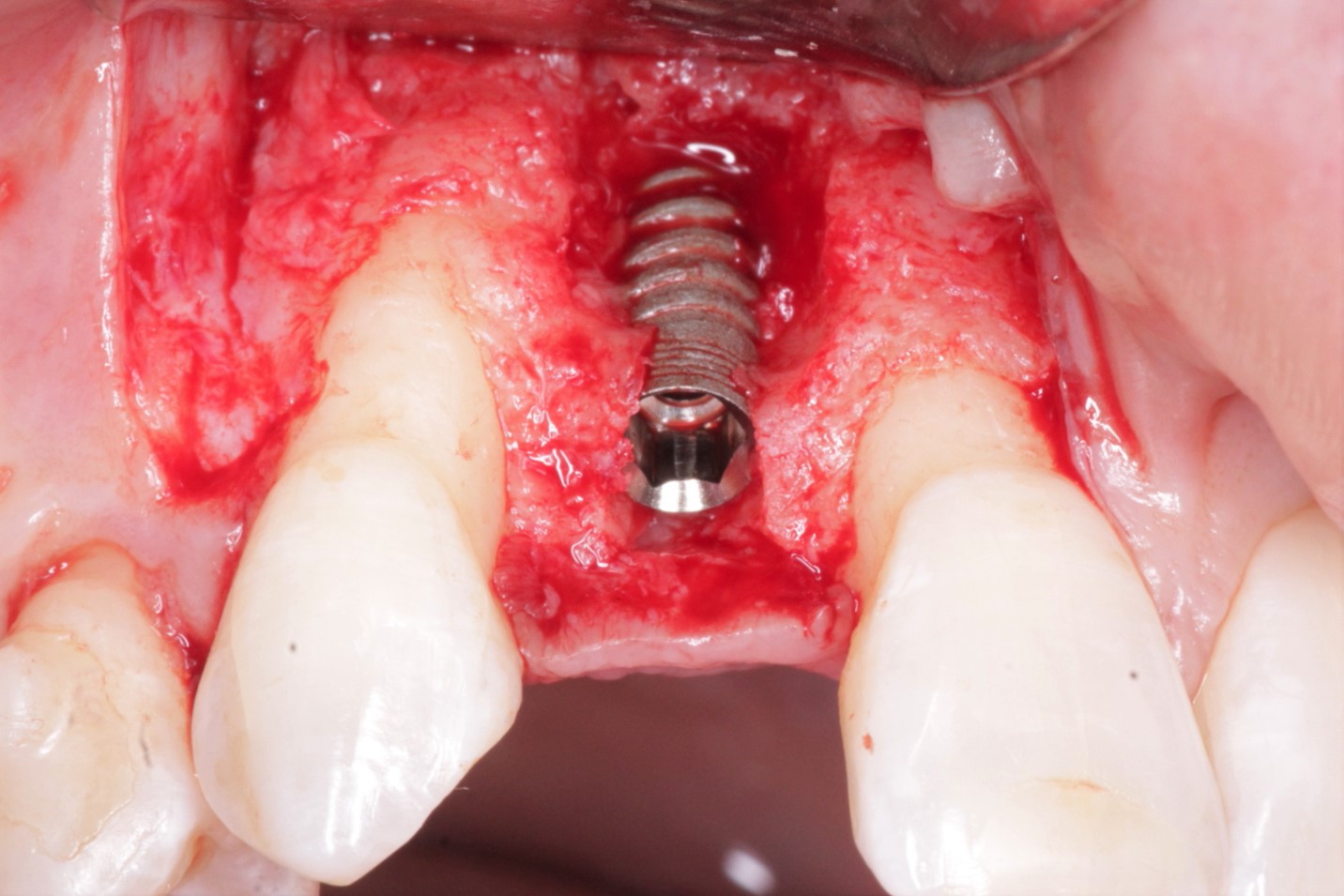Bisphosphonates: What is the Latest Protocol?
Dr. TF asks:
I have read several articles and comments on Bisphosphonates, as it relates to dental implants, but this whole matter keeps developing and changing. What is the current protocol for managing dental implant patients taking Actonel? Is it to stop taking Actonel for 6 months before implant placement? I’ve already consulted with the patient’s physician and he has no clue. Are there any blood tests I can ask the patient’s physician to use to determine suitability for implants? Are there any special precautions that I should take prior to or after the implant placement? Thanks.
14 Comments on Bisphosphonates: What is the Latest Protocol?
New comments are currently closed for this post.
Nicholas Toscano DDS, MS
12/1/2008
The Jury is still out on what is the best protocol. I myself follow the Marx protocol. Marx has a great book out on this subject and anyone treating these patient should buy it.
Here is a summary I compiled from articles and Marx's text. One should use one's best clinical judgement as there is no specific guideline out on treating this population of patients.
Bisphophonates induced ONJ is defined as non healing bone in the mandible or maxilla present for 8 weeks in a person that is on Bisphophonates and hasn’t received radiation to the jaw
Key Facts
- IV meds are worse then the oral
- IV induced ONJ is treated with antibiotics and peridex, surgery makes it worse, so you manage these patients you can’t cure them.
- Oral ONJ can be managed with surgery under the right circumstance
- Exposed bone is dead bone----No pain, pain is associated with secondary infection. So if you take out teeth-----it can lead to necrosis if not done at a safe time.
- Risk increase after being on oral med for 3 years.
- there have been 140 IV cases and 40 oral cases of Bisphophonates ONJ
Mechanisms
- Bone renews itself through osteoclasts. Bisphophonates inhibit osteoclasts by killing them when they take up the drug during resorption.
- IV drugs build up in the bone to a toxic level within 6 months, the drug binds to HA in bone
- Oral drugs take up to 3 years to build up to the same toxicity
- Oral drugs are Fosamax, boniva and Actinol
- IV drugs are Aredia and Zonita
- The jaws get hit hard because the jaw bone remodel 10x that of long bones
- First signs of ONJ are Sclerosis and thickening of the lamina dura, widened PDL, mobile teeth and pain
- Incidence is .01-1% of oral and .8-12% for IV
Treatment
Peridex
Antibiotics PenVK first line and then Levoquin(Limit to 21 days due to liver toxicity)
Organisms Actino, Eikenella etc
You want to reduce the risk of secondary infection and osteomylitis
Dental co morbid factors include Perio disease, Caries, Abscess, Failing root canal
Medical Co morbid include- steroids, RA, SLE
Prevention:
1) Non invasive dental procedures are safe at all times,
2) Invasive dental procedures safe before 3 years
3) After 3 years- drug holiday with consent of prescribing physician to a CTX of ≥150 pg/ml
After 3 years need a serum C terminal telopeptide test- CTX
CTX ≤ 100 pg/ml = high risk
CTX = 101-150 = Moderate Risk
CTX ≥ 151 pg/ml = little to no risk
CTX improves significantly with discontinued oral Bisphophonates
CTX is a marker for bone turnover and healing- measures osteoclast function- it is a fragment cleaved during bone resorption
50% of case will spontaneously heal and 50% need surgery.
Treatment regimen
1) Obtain Reference CTX
2) Drug holiday of 4-6 months with approval of prescribing physician
3) Treat with .12% peridex and antibiotics
4) Monitor CTX until a value ≥ 151 pg/ml
5) Spontaneous resolution vs. treat surgically
CTX test
Fasting blood
Morning sample
Send to Quest Diagnostics 1-800-642-4657
Please remember the above is a guide I use based on what I have read in the published peer reviewed articles, Dr. Marx text and my clinical judgement and should not be treated as law. There is constantly new info coming out every day so any protocol should be used with caution and consultation with the patients attending doctor.
william richter
12/2/2008
I had a patient that had evulsed pieces of maxilla coming out only after three months of oral medication. She was wearing a denture over the implants and perhaps this caused an irritation with a subsequent infection, that triggered a more severe reaction? The mandubular implants survived. The mandibular implants were place before she went on the Fosamax.
Mike Heads
12/3/2008
I agree with most of Dr Toscano's ideas but if I could just correct him on two things. Firstly it has now been shown that the CTX test is of little use as it looks at cancellous bone, ONJ is related to cortical bone which has a slightly diffrent metabolism and therefore the CTX test does not show what is happening in this bone. Secondly a bone holiday is of little or no use as most of the bisphosphonates have now been shown to be active in the body for at least 5 years after stopping treatment. The ADA presently recommend treating one tooth in the mouth, taking all the precautions previously mentioned by Dr Toscano, and then waiting two months and if all is OK then proceeding with further treatment.
John Clark
12/3/2008
Not 100% but in Australia the use of hyperbaric Oxygen therapy has proved to be fairly successful in dealing with osteonecrosis but it requires quite a few sessions and is expensive. At a recent oral cancer seminar I attended at the Uni of Qld, it was also mentioned that the experimental use of hyperbaric oxygen prior to post surgical irradiation showed great promise for the future though it is a contentious issue in that some argue that the oxygen may be benificial to any cancer cells still present....
prof.Dr.Hossam Barghash
12/3/2008
dear DR.Clark
HBO (hyperbaric Oxygen) has no place in treatment of bisphosphnate related osteonecrosi.we can,t compare it with radio osteonecrosis which has a totaly different pathology.HBO rational use in radionecrosis based on compensation for diminished blood supply of bone. which is not the case in BRONJ.bisphosphnate work on osteoclast inhibiting it is action & that is the rational for it,s indication.A lot of dentist percive osteoclast as bone destructive cells, this not true , I do describe osteoclast as the immune cells for bone, imagine dead tissue without macrophage.
Mike Stanley, asst.
12/3/2008
Dr. Toscano, thank you for the synopsis. Our practice hasn't seen many patients with these meds yet, but we all WILL, very soon.
JOHN JOHN
12/3/2008
Dr. Toscano and Mike Heads Thanks for the info.
Mike do you have a reference for what you are saying on the CTX and ADA recommendations?
R. Hughes
12/3/2008
Dr. Toscano presented a very nice review!
CTG
12/7/2008
Very good review there by Dr. Toscano , thanks for the input. However.....
The AO currently discourages treating patients under Oral Bisphosphonates with dental implants that are more than three years duration of OB. And the ADA guidelines are mentioned above.
That, in my opinion, is blowing the situation completely out of proportion. Look at Jeffcoats review ( in JOMI)of 2 articles of patients on OB recieving implants and Fugazotto's article (in J perio) where OB patients with average about 4 years duration recieving implants ... both these articles... ZERO complications
It is my personal opinion that OB is actually helpful in dental implant therapy and even more so in GBR procedures...
What i would like to see more work on is the effect of OB on more extensive bone grafting procedures.
Bear in mind however , this is all concerning ORAL bisphosphonates. IV is a whole different animal when it comes to ONJ.
GT
1/7/2009
Could anybody tell me the effect of Actonel (which has been taken orally for 5 months)to bone augmentation procedure? Should the patient taking a drug holiday before the procedure and afterwards? Would the patient need a premedication before treatment (such as taking some drugs)and afterwards? Would there be any advantage in these case if I use PRP (Platelet Rich Plasma) for the bone augmntation procedure? Many thanks.
F. Grant
2/11/2009
IV bisphosphonates are only used in limited oncology fields and some rare bone disorders such as Paget's disease- a fairly small patient group. Oral bisphosphonates are used by every second female patient over 60 who walks into my practice. The risks of ONJ are explained to the patient in relation to their drug treatment,- ie oral treatment carries a very small risk of ONJ. Drug holidays are useless as it can take years for drug to clear.
Dr.elie abdo
5/25/2009
hi. i did a seminar on management of patient receiving BP therapy in oral surgery.
i'd like to notice:
- the I.V form content 12 times more BP than oral form.
- the half life duration in bone is up to 12 years.
for oral form systemic risk factors are:
- after 3rd year of therapy.
- age over 70.
- patient under corticoid therapy.
mangement in oral form include treatment under antibiotic and chlorexidine 0,12% and under sterile condition with minimal invasive surgery.
treat one quadrant and wait 2 months if no problem occur then proceed for other sectors.
for I.v form once therapy begins we must avoid any surgical act for 12 years after treatment.
for implant we must be sure to have fully osteointegration before the first injection that mean 12 to 18 months.That's why the correlation with the oncologue is primordial.
newsom,jk,md
9/8/2009
found your sight this am...my 75 yo mother is s/p radiation tx, 10 years ago for "low grade" parotid tumor...several years oral biphosphonate tx...with only recent pathologic fx r mandible...i'd not encountered previuosly differintiation of ischemic injury related to radiation vs osteoclastic cytopathology from op tx...i guess she may suffer both tho' has seemingly benefitted none from hyperbaric o2. i appreciate this forum and informative discussion about a pathologic entity i have only encountered
Dr. Rostami
10/8/2010
Can you please provide citation for "oral bisphosphates build up to the same toxic levels as Iv in 3 years" thank you

















